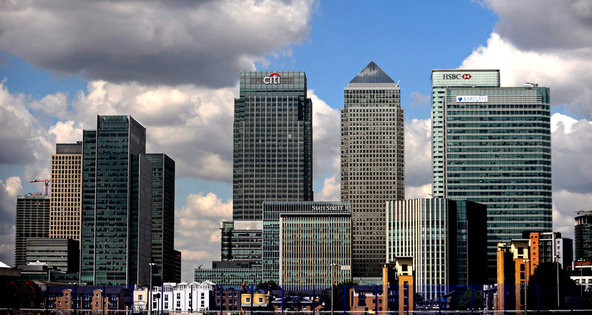The ceremony celebrated a decade-long building boom at La Défense, the sprawling array of office buildings long envisioned as Paris’s answer to Lower Manhattan or the City of London.
But La Défense, begun during the presidency of Charles de Gaulle in the late 1950s and built just west of Paris by bulldozing slums and paving over farmland, has always worked better in architectural theory than in anthropological practice.
Rather than the Parisian business hub its founders described, it often seems more like the isolated end of a spoke that has highlighted a crucial flaw in urban planning — a concern with making architectural statements — rather than an affinity for the people in and around the buildings.
When non-French planning experts assess La Défense, they say it shares the same problems as the Canary Wharf complex in London, where developers have tried to supplant the City with Big Architecture and whose artificial origins may be hard to overcome. The experts look more favorably on the somewhat organic mix of business and residential of Lower Manhattan, which has evolved over the last century.
“La Défense has always suffered from a creative hypothermia,” said Wojciech Czaja, an Austrian architecture critic. “It is a sad area because it is atmospherically and emotionally perceived as a business district only.”
The public agency that manages the complex has hired an architectural firm to draft a new master plan in hopes of making the grandiose vision for La Défense a livable reality. It is difficult to determine whether the plan can withstand the headwinds of Europe’s continuing financial woes, and France’s lingering recession and an unemployment rate near 11 percent.
But it would be wrong to call La Défense a business failure, because it is home to 1,500 head offices, including those of 15 of the world’s 50 largest companies. French corporations with their signature headquarters here include the oil and gas giant Total, the big bank Société Générale and Areva, a leading builder of nuclear power plants. And developers continue to build.
Critics have long derided the mixed commercial, residential and retailing complex, which covers 1.6 square kilometers, or 0.62 square miles, as dehumanizing. While about 20,000 mainly low- and middle-income people live here, the vast central plaza can feel like a ghost town after 5 p.m. and on weekends, once most of the district’s 150,000 office workers have left by train, bus or subway to more desirable parts of Paris or its less surreal suburbs.
“There is nothing good about living here,” said Carlin Pierre, 54, who works at a waste disposal center in the district and resides in one of the Brutalist communal, rent-subsidized housing blocks tucked amid the high-rise office buildings. “Sure, it’s a nice area to come as a tourist, or even to work,” Mr. Pierre said, “but it’s terrible to live in La Défense.”
Alessandra Cianchetta, a partner at AWP, the firm mapping the master plan, acknowledges the enormousness of her task. “La Défense as a concept is a bit obsolete,” Ms. Cianchetta said. “There is no interaction, no hospitality here.”
Vacancy rates at La Défense, long an up-and-down indicator of the French economy, are once more on the rise. Next to the Grande Arche is the site of what was to be a 71-story office tower, Tour Signal, commissioned with much fanfare in 2008 to the French architect Jean Nouvel. It has been canceled.
Still, three new, architecturally ambitious office towers are under construction at La Défense. And the recently financed Hermitage Plaza project on the Seine River at the easternmost edge of La Défense, if it opens as planned in 2018, will include Europe’s tallest residential building. Some of the continued activity, of course, has to do with the long lag between conceiving a commercial real estate project and getting it built — a speculative roll of the dice that has paid little heed to shorter-term considerations like France and Europe’s current economic travails.

Catherine Chapman contributed reporting.
Article source: http://www.nytimes.com/2013/07/31/business/global/a-new-effort-to-bring-life-to-paris-financial-district.html?partner=rss&emc=rss
